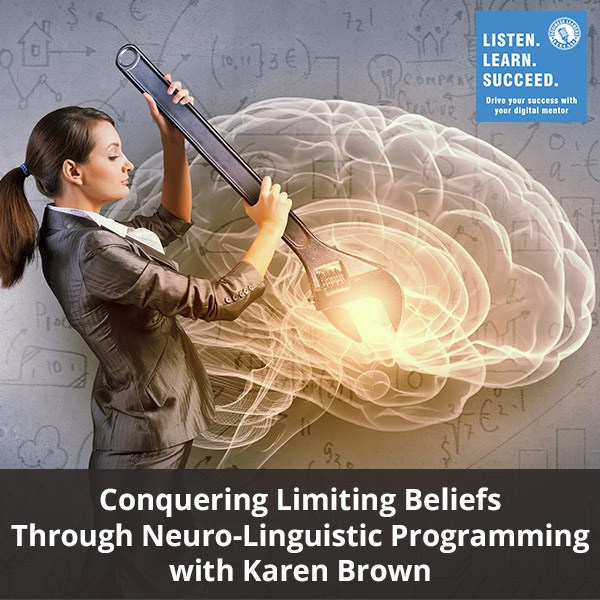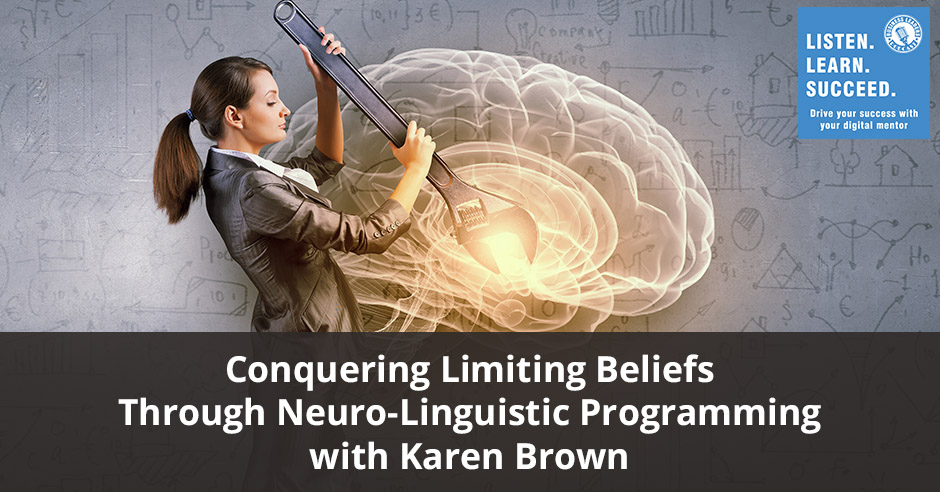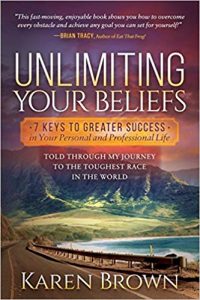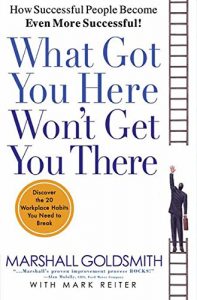Conquering Limiting Beliefs Through Neuro-Linguistic Programming with Karen Brown


The key to our failures and successes always lie within us. Aiming for the latter, we have the CEO and Executive Leadership Coach at Velocity Leadership Consulting, Karen Brown, to talk about how the science of words or neuro-linguistic programming gives a window into what is going on in us that hinders our greater success. Karen guides us to find the blind spots in our behavioral patterns and address the limiting beliefs that hold us back from taking action. She also directs us to the fears that we keep locked down in our unconscious mind, urging us to overcome them and eventually lead better with the capacity to transform the world.
—
Conquering Limiting Beliefs Through Neuro-Linguistic Programming with Karen Brown
 I am an expert in behavioral blind spots and identifying them. How they’re hindering greater success and by resolving them, you get greater success
I am an expert in behavioral blind spots and identifying them. How they’re hindering greater success and by resolving them, you get greater success
We are so fortunate that we have Karen Brown on this episode. She’s the CEO and Executive Leadership Coach at Velocity Leadership Consulting. Karen, thanks for coming down.
I’m happy to be here.
Karen, tell me a little bit about your business and who you serve.
In Velocity Leadership Consulting, our mission is to elevate leadership performance and impact with greater velocity and ease. We do that through one-on-one executive coaching using neuroscience techniques. Everything we do is scientifically proven effective.
There’s that E word. In some of the backstory, for you, there’s a journey. Karen was nice enough to let me know she has a book out and I read the book before getting together. If I’m the business owner and I heard you said we help leadership in Velocity, what does that look like when you show up day one at my business?
What that looks like is I’m going to ask you a lot of questions. Most of which I probably know the answer to but I want to hear what you have to say and how you say it. This goes back to something called Neuro-Linguistic Programming which me and all of our coaches are experts in. It’s the science of the words that you use to express yourself and it gives us a window into what’s going on for you. Specifically, what are the blind spots in your behavioral patterns that are holding you back from higher levels of success? We tend to work with either high performers or the person in the organization who is the trouble spot. We also work in areas of succession. Maybe someone’s been identified as the successive candidate and maybe they have some developmental work to do. Whatever it is, it’s going through those blind spots and identifying them. I’m adept and I would say, if I have a special gift it’s that, being able to see behavioral blind spots in an instant. From what I ask someone and how they respond, I can see exactly what’s going on and then ask them a question to open that up even further so that they can see it.
By and large, at some point you pretty much see all the problems that you can see, if you’ve been doing it long enough.
I think that until a new problem emerges and then I go, “I haven’t seen it all yet. I thought I had.”
We’ve all risen to a nice level of success, and that’s also where our blind spots live.
Is there a typical leadership challenge, blind spot that you see most of the time?
Yes. Number one that every single executive we work with talks about is not having enough time to achieve what they want, which is ultimately a blind spot and a limiting belief. It’s something that they thought maybe it was possible, they tried it. They tried to achieve it, they couldn’t get to it and they gave up on it.
There’s no hope of getting it fixed. I’m your leader and I have more to do than they and you come in and go, “Bob, here’s what I think would be a good remedy. This is what I would tell you to do to get control of your time.” What would you tell me?
First of all, I don’t tell you very much. I ask questions because you have the answers. You’ve not ever had someone like me that can look behind the scenes and ask the right question to unearth the answer. I’ll ask you a question like, “Look at your schedule, what is the biggest time bandit that you have? Where do you lose the most time?” We go from there. I’ll say, “What can we do differently with that?” First of all, we need to identify, what’s the point on the horizon that we’re going for? What will your schedule look like when you do have enough time to achieve everything?” You also have that crazy idea called work-life balance, where you are no longer working at home on weekends and evenings. Your spouse and your family don’t have to put up with that from you anymore. I guarantee every executive out there, I’ve not met one yet, that their family doesn’t do that. They all do that.
When that executive goes through the training and all of a sudden he or she start showing up on the weekends, how’s that resonate with the family?
They love it. A couple of quick examples of that, one client and his wife actually used to work in the same company. It’s a large regional bank here in the area. He was very quick when we first started working together to tell me, “My wife worked in the company so she knows how it is.” I said, “What you’re telling me is she will fall prey to the same excuses that you use.” He sat there and went, “Probably.” He’s the same client who, when I said to him, “Here’s the truth. You do have enough time to get everything done during the day and not work at night or on weekends. You gave up on this because you didn’t find the way to achieve it. I’m here to help you with that.” Fast forward, he typed in his notes that day in our client interface system. He said, “Karen said it was possible,” and I remind him of that because three short weeks later, he’s not working at night. He’s not working over the weekend. His wife actually had the realization, the awakening of, “I was falling into the same excuses that you did because I didn’t think it was possible either. It was a goal that I had way back when that I let go of because I didn’t find the right strategy and I couldn’t make it happen. I gave up.”
I imagine there’s some level of pushback. When you get the pushback from them, what’s your typical rejoinder to them when they’re pushing back?
My favorite thing to say is, “How do other people that are more successful than you do it? Richard Branson, Jeff Bezos and Warren Buffett, how do they do it?” I say, “What’s the evidence that shows you that they’ve achieved a higher level than you?” They can’t argue that and I say, “Do they still have 24 hours in a day like you do or have they invented more time somehow?”
 Unlimiting Your Beliefs: 7 Keys to Greater Success in Your Personal and Professional Life; Told Through My Journey to the Toughest Race in the World
Unlimiting Your Beliefs: 7 Keys to Greater Success in Your Personal and Professional Life; Told Through My Journey to the Toughest Race in the World
You were talking about in the beginning and velocity is part of what you do. You mentioned the three-week timeframe. For transformation, what’s the timeframe typically that you see for a committed student that’s willing to be coached?
This is where it gets great. For someone who’s willing to do the work and make the changes, we always start out with a six-month engagement. I always let this play out. I don’t set up the client for this. I let them discover for themselves. About six weeks in, we have accomplished all of the goals and objectives that we’ve established at the beginning of the engagement. We come to that session and I review the goals and objectives with them and say, “Have you achieved what you wanted to there?” Yes. “How about there?” Yes. “How about there?” Yes, and then the light bulb goes on and they go, “I’ve achieved everything that we set up for six months in six weeks. Now, can we work on this, this and this?” “Of course.”
As you come into an organization and I’m sure that everybody that looks at this leader goes, “That’s a change.” What’s the dynamic in the organization when the leadership goes through this transformation?
The impact is enormous. I’ve gotten a lot of feedback from others in the organization who have said, “The change is so remarkable. It’s marked difference. It’s transformational. They were good before to work with or they were a good leader and now they have completely leveled it up and they are delightful to work with. They are a pleasure to work with and they’re helping me. I can see that they’re helping other people because they’re so much better. They’re adept at actually effectively coaching their team.”
In the financial metrics of a company, is that something that you observed pre and post your engagement?
Yeah, we have KPIs that measure all of that and they’re on our website.
What do you typically see?
I typically see a 48% increase across the board and even oftentimes that will translate into net profit.
I think about the audience going, “I’ve had consultants. I’ve had this and that and the other. There’s a cost and I think if you have a good number moved up in your bottom line, then it’s an investment not an expense.” What many of the folks may not know is that you participate in some extreme sports. The part that I’m interested in is not only the fact that you participated but you’ve recognized along your journey that you needed to bring on a coach or two. Let’s talk about that moment when you were doing what you were doing and getting what you got. You finally decided that I have to take and get somebody to help me or coach me.
To explain that, I need to back up even further than that. I spent the better part of twenty years being a successful senior executive in the corporate world and also being an internal business coach for my team members. This is before coaching was even a thing.
The power of fear is alleviated after you verbalize it. When you let it out, you let it go.
You started very young.
This is before coaching was a thing and you did this as team building. You did it because you were a good leader and you want to bring your people along. You want to help them perform. I was very adept at coaching and I also found that there was a
lways this place that we couldn’t access. We could only take that coaching work so far. What I later found out through my journey to the IRONMAN is what I was feeling was the unconscious mind and neuroscience techniques, which is one of the reasons why I founded Velocity. That’s why we do the work that we do. What we were coming up against were behavioral blind spots and the way that you work through those is through unconscious mind and neuroscience techniques.
Neural-Linguistic Programming like I talked about and a whole bunch of other stuff that you have to go to school and study a long time for and be fascinated with human behavior which I am. Learn that and then fast forward to the beginning of my IRONMAN journey, I decided to pursue this crazy, big, hairy, audacious, gargantuan dream of mine which had existed for 28 years. I wanted to compete in the toughest race on the planet, which is the IRONMAN World Championships as a recreational athlete. I had never ridden a road bike. I was a terrible swimmer. I had never run a marathon and I had never completed a triathlon of any length and yet I wanted to do a race that’s 2.4 mile swim in the ocean, 112 mile bike ride and a 26.2 mile marathon. It’s absolutely nuts. I finally discovered limiting beliefs and that’s one of the reasons I wrote the book.
I read it as well. It’s a good book. Pick it up, you’ll learn lots.
What held me back for 28 years for me even pursuing the IRONMAN and come to find out other professional goals that I didn’t realize I was holding myself back from, is something called limiting beliefs. When we think or say, “I don’t have enough money, time, talent, buy-in or whatever,” fill in the blank to achieve X. That’s always what I thought about the IRONMAN. That’s what holds all of us back. This is how our unconscious mind is wired. It goes back to cave man days, but come face-to-face with that, learned how to conquer that, which I also give you the key to that in the book. There’re also keys to that on my website. I decided to pursue the IRONMAN and I’m ready to jump in with both feet. Come hell or high water, I am doing this. Then I realized, “I don’t know the first thing about this. I don’t even know what I don’t know yet.” It might be a good idea to do something different than I’ve ever done before which is to hire a coach right out of the gate. I don’t even know what questions to ask. I was actually at a barbecue and I had just started verbalizing to other people that I was pursuing this dream.
Did they move away from you?
Yeah, rapidly. They ran the other direction except for a very kind person who I met and shared my dream with said, “You probably want to hire a coach,” and I played it off very well, I must say. Inside I thought, “That’s the best idea ever,” and I said, “Do you know where I could find one?” He said, “I have a couple of names actually, my cousin did this.” Monday morning, I was interviewing the coach that I ended up hiring who had gone herself to the IRONMAN World Championships multiple times and had helped other athletes get there as well. I hired somebody that had done what I wanted to do. That was the golden ticket and I had to talk this person into taking me on. I was a super no one and I said to her, “I will do whatever you tell me without question and I will be your most committed athlete.” That was true and I said, “The other thing about me is, I will never give up, never. I will do whatever it takes to get there.” That’s exactly what I did. That’s another key in the book.
That’s a committed student and coachable. The part that that struck me as I was reading in the book and thinking about what you do for a living, the genesis of this notion about bringing the coaching and bringing the insights from something that’s out of your comfort zone. I think about gender issues. You come in to talk to the “CEO of the company,” do you see much pushback in expectation? Do you get much of that in your industry anymore? They go, “You’re diminutive,” at what point in time they go, “She is to coach.” Do you get much of that anymore?
Some, it depends on how big their ego is. I get it from women too but from the opposite side. From women, it’s their disbelief. I’m not enough or what I call the Oxygen Mask Syndrome that, “I’ve got to help everybody else before I help myself or before I do something to help myself.” I always say, “You’re going to suffocate first. That’s how it’s going to be.” That is what cuts through and alleviates the pushback which is me being direct just telling them what I see and saying, “How’s that working out for you? It doesn’t look to me like it is working out for you.”
 Neuro-Linguistic Programming: Being able to walk alongside someone instead of pushing them is our gift that we give to other human beings.
Neuro-Linguistic Programming: Being able to walk alongside someone instead of pushing them is our gift that we give to other human beings.
At some point in your athletic endeavors, were you still working in the corporate world?
Yeah, in fact, this is the other reason for founding Velocity. A year after I crossed the finish line at the IRONMAN at age 46, I was fired from being a CEO. I thought I was doing a great job. It took that level of pain for me to recognize my blind spots because at first I blamed the board. I blamed politics and all the typical stuff. I finally had to come to grips with what caused me to be fired, which was these behavioral blind spots that I was unaware of.
It’s a tough pivot. I think about that and here you are on whatever day it was after you’re going, “I haven’t ever been fired.” What was that thought process going on between your ears?
Like a lot of achievers and this is why I bring this up because probably everyone in your audience, we’re all type A, we’re all achievers. We’ve all risen to a nice level of success and that’s also where our blind spots live. What was going on between my ears was, “If I had these blind spots, what was it costing me, others and the organization?” That’s when I began to feel really badly about it. I could have been so much better than I was. I could’ve been so much more effective than I was. I wish that someone or something would have pointed this out to me. I would have seen it and been able to do something about it. That’s a major reason why I founded Velocity because I thought, “I don’t want to see that negative impact or opportunity cost anymore.”
Do you think you would’ve recognized the blind spots without this event?
Amongst achievers there does have to be a level of pain, to get us to sit up and pay attention. I will say this, I would have sat up and listened had it had it come from the mouth of someone I respected. If I highly respected them and they said, “Sit your butt down and let’s have a direct conversation about this.” If they had pointed them out to me, yes, I would have sat up and taken note.
You left the job and you made a choice. Did you start Velocity right after that?
I did.
That had to be pretty riveting and scary.
The state of your company is nothing more than the state of your mind.
I felt that was the right thing to do that was like with IRONMAN, I felt like that’s what I’m meant to do that’s what I’m called to do and that’s the mission. Even though I’m afraid and I don’t know exactly what I’m doing, I do have the experience, the credentials and the background to know what I’m doing. At the same time, I was also still developing myself. I think that’s a good thing, to be able to walk through that with other people that’s the gift that we give to other human beings, to be able to walk alongside someone. Instead of pushing them, pulling them, to walk alongside them and say, “I get it and you aren’t serving anybody by staying there.”
I think about all the instances of fear through your early life. You developed a mechanism to deal with fear. What do you do mentally, physically or practically to help manage that fear to where you have an action plan?
First of all, I become aware that that is what’s showing up, “This is fear,” and actually I call it my friend, fear. I literally visualize that it’s a friend showing up. It makes it much easier to embrace it. I’ve read lots of research and watched lots of videos about this. There’s one from a great female skier. The winningest female skier ever in history. What they all share is that you have to embrace fear. You can’t block it out and continue to block it out because eventually it will overcome you. You can’t crowd it out, turn away from it or whatever phrase you want to use. You ultimately end up having to embrace it in some way and walk through it. I found that to be the most helpful in whatever outlet that was in. That also has to do with expanding your comfort zone. I never look at that anymore as stepping outside my comfort zone. I look at it as an endless expansion of our comfort zone that never snaps back.
You described the forethought on the three events at the IRONMAN and you were talking mentally about what you were doing. Getting into the mindset, you’ve got the swimming and somebody is drafting you.
I’m the slowest swimmer on the planet and someone’s drafting?
You think about it, you come out of the water and then there’s a routine to get ready to go. I think you did the bike next and then the run was last. There’re all those transitions and notions and we’re talking about hours of exertion.
It’s almost sixteen hours in my case.
I think about it in the day-to-day world when you talk to a CEO and the CEO says, “I have this raft of problems. The company has this, this and this.” How do you convey that angst or fear of management in a discipline that they can adopt?
We walk into it, first of all. I ask them point blank, “What’s the worst thing that can happen? Let’s have it. What’s your greatest fear?” Because there’s power in verbalization. First of all, the power of fear is almost alleviated after you verbalize it, after you let it out, you let it go. It’s so much easier to deal with. We say it. It feels so much better.
 Neuro-Linguistic Programming: Have compassion for others who are in very difficult and challenging circumstances because most of the time, people are doing the best that they can or the best that they think they can.
Neuro-Linguistic Programming: Have compassion for others who are in very difficult and challenging circumstances because most of the time, people are doing the best that they can or the best that they think they can.
I have to see it. I’m a big fan of if I have the challenge then I’ll take and convert it to written format. Once I did the written format, I’ll go, “Can they kill your ego?” “No.” That isn’t going to happen and I stepped through all the things that I can think of. The course of action when I’m done and then I can manage that. I check it off and work through. That’s my mechanism. It doesn’t mean it’s the right one, it’s the one I use.
It’s interesting that you say that because when you write things out like that and then you see them on the written page that’s actually a doorway into your unconscious mind. I’m not surprised at all that works. That’s what we do to conquer limiting beliefs. You got to write it down first. List it, interrupt that thought pattern and then rewire it. That’s exactly what you’re doing there.
That’s why you’re calling fear your friend. You’ve re-characterized it. So much of that I see in the business owners and with my kids. There’s that scarcity mindset periodically that comes into play and there’s scarcity of time. The role model, you have to work your butt off all the time to be successful. I know you have to work smart and not hard, necessarily. We’ve talked about the IRONMAN. You didn’t stop at the IRONMAN, did you?
I will tell you this, at the time that I chose to finally pursue it, it was the biggest thing I could think of. I felt like my mind couldn’t expand beyond that. It was the biggest thing that I could fathom until the year leading up to when I went to the IRONMAN World Championships. I ended up reading a book that’s wonderful by Rich Roll, Finding Ultra. It’s excellent. What he described was this Ultra-triathlon called the Ultraman which is a three-day, 320-mile triathlon where you circumnavigate the big island of Hawaii and that blew my mind. For about several months, I was pissed at him. You’ve moved the bar. Now, there’s something bigger, tougher and longer than the IRONMAN and I cannot wrap my head around it. I don’t even know how you would do that. I was training 22 to 24 hours a week by then and I thought, “Surely you don’t double that.” This is more than double the distance.
There’s a diminishing return.
I sat with that for a while. I crossed the finish line. I continued to sit with it and contemplate it, “How could you do that? How would you go about that?” Which is another technique that I think is effective for us to contemplate things and figure things out because what we’re actually doing is asking our unconscious mind.
I call it stewing. I have to stew on it. It usually comes to me behind the windshield.
When we’re not forcefully thinking about it, when we’re not pushing on it, it bubbles up and you go, “Where did that idea come from?” That’s our unconscious mind at work. One day, when my swim team swam a 10k in the pool, it all clicked in. I thought, “You just build the volume. It’s not double, you build it systematically.” Then I thought, “I want to do that.” I basically jumped headlong into the ultra-endurance world and then over the next six years, I completed eighteen of the world’s most difficult races all over the globe. I had a ball and continued to expand myself.
I think mileage is probably the right and wrong term. You think about all the places that you ran, all the challenges and weird stuff, like one you lost a straw. The other one, your stem was too short on your tire. You think about the odd things you have to learn to cope and overcome in creating resiliency. When you look back over your ultramarathon journey or career, what do you think of the top one or two takeaways that you bring into your coaching from that?
Open up your own mind to make sure that you’re not placing your own limiting beliefs on them.
That’s an easy. Number one, I can do anything. I am truly capable of carrying out anything I can think of and so is every other human being. That’s the fascinating thing to me about our unconscious mind. It’s a spectrum and on one side of the spectrum is limiting beliefs. You’re thinking up reasons why you can’t do something. The other side of the spectrum is the ability to carry out anything you can think of. There are a gazillion stories out there, Iron Cowboy, EPIC5, the Ultraman, scientific endeavors and business endeavors. The list goes on and on. That’s the cool part. That was my number one takeaway that no matter what happens, I can figure it out. I can get through it and that’s another thing I think that we bring as coaches to our engagements with executives. They have a myopic view of that, “For these things over here, I can do anything,” but it’s these blind spots over here, where they lose that ability.” That’s what we very definitely point out. The second thing that I took away from my ultra career is compassion and that might sound surprising but first of all, compassion for myself because I was grinder. I would just grind myself into the ground.
You got to take care of the machine.
Also mentally, spiritually and emotionally, I learned compassion for myself which was a tough thing. I’m hard-headed.
You hold yourself to a standard and you go, “This must mean, if I don’t do that then.”
I should be able to do that first time out. I should be here by now. My business should be here by now or this person should be here by now or things like that. The other thing that it taught me was compassion for others that seeing people in very difficult challenging circumstances. Realizing that most of the time people are doing the best that they can or the best that they think they can.
They’re out there.
I have to meet them where they are, not where I think they are. There’s a big difference there. I think as leaders, that’s a very powerful insight because how our mind, how our brains are wired is to be assumptive. If I see somebody and they’re doing this or they’re not doing this, I’m going to assume that this is what’s going on. They’re lazy or whatever, we assume. It’s hardly ever true. It’s hardly ever accurate but we also, as leaders, as we’ve ascended, we’ve gotten into this habit of asking less and less questions and making more and more assumptions and then telling people. That’s honestly the model of leadership that most of us were raised with.
It’s the autocratic military leadership style, being ex-military.
You rise to that level because you’re the best at doing something.
 Neuro-Linguistic Programming: The new CEO sometimes fails to realize that they do not have the ability to see clearly until they’ve ascended to the big chair and fail.
Neuro-Linguistic Programming: The new CEO sometimes fails to realize that they do not have the ability to see clearly until they’ve ascended to the big chair and fail.
It’s expected.
Then what you do is, you’re the best at it, you feel, “I’m going to tell everybody what to do, why you need to do it and then I’m going to expect you to do it.”
On top of that, if it’s the only role model you’ve ever seen, this is the only set of effective leaders I’ve ever seen and that’s what you mirror. It’s like parenting, you only get to see your parent’s model.
Unless you break that pattern and take a different approach.
I think in the scheme of things, somebody says, “I really had a bad day.” I suspect you know what a bad day looks like. It doesn’t look like most days. For you, you were talking about your audacious goals, your running career and marathons, what do you got cooking for your next challenge or audacious goal?
I’m working on two big missions. Our mission with the book is to eradicate limiting beliefs and transform the world. If we think for a minute about how our lives, the lives of those we care about and the world will be transformed when none of us suffer any longer from limiting beliefs. Thinking that we’re not good enough, we can’t do that and we don’t have enough to do something, the world will truly be a different place. That’s mission number one and then mission number two with Velocity is to elevate leadership performance, impact with greater velocity and ease. I’ve gathered some anecdotal data as I’ve been working in this field over the years.
What I’ve found is about 40% of all the leaders I run across are self-aware and they raised their hand willingly and say, “I know that I can be better. I want to improve and I’m willing to do the work to bring that about,” and it’s the other 60% that I also want to make a difference with because they’re the ones who are still blind. They’re probably like I was or maybe even worse when I was a CEO and was fired. I had behavioral blind spots and I didn’t see them. The problem is that people are leading their organizations, no one will tell them the truth. Even pretty good leaders, no one has the balls to tell the CEO the truth.
It’s a career limiting move.
They see that it is.
We are truly capable of carrying out anything we can think of.
They tell them on the way out the door, which is usually not received well.
The CEOs that we work with, they welcome that. They want debate. They want someone to disagree with them and that’s a healthy thing, to debate something and see another point of view.
For the new CEO, he/she comes into an organization and the previous CEO was in the 60 percentile that you’re talking about and the new CEO says, “I’m looking for feedback, discourse and I don’t have it all figured out and so on.” How does that CEO frame that to the organization where that occurs?
This is lovely because this is something that we’ve just undergone with a leader, a CEO in that very circumstance. First of all, he/she doesn’t say, “I don’t have it all figured out,” but he/she will admit, “I don’t have all the best ideas that’s why I have assembled all of you,” He/she will set that up to say, “In this confidential space, where we meet, I’m going to encourage vulnerability,” and you can say, “I don’t know,” and own it. If you don’t know, that’s okay but if you need to go figure something out, then do it. We’ll all support you to do it. Also, to be a facilitator, to be great at asking questions is how you coach people effectively, to keep asking the best question that gets them to do their best thinking is the most effective coaching.
Do you have a favorite question?
I have lots of favorites.
What’s one or two?
“If you could create any result that you wanted, what is it? Also, “If you could rewind the clock and do it over, what would you do differently?” it’s hugely revealing, but even sometimes leaders will share with me, as they were doing it, they almost had that hindsight going on, “I don’t think this is maybe the best way I should be doing this but I’m the leader and I have to follow this through.” That is a pattern. That’s exactly what we work on. We say, “Take that awareness and actively make a shift to your approach before you take it.” “What approaches could you take?” We’ll talk through that because there’s so much that goes on that I think it’s incumbent upon CEOs. Whether they’re seasoned, they’re new or they’re somewhere in between to be able to effectively help their senior leadership team, their team or whoever that is to think at a higher level.
 What Got You Here Won’t Get You There: How Successful People Become Even More Successful
What Got You Here Won’t Get You There: How Successful People Become Even More Successful
I think about new a CEO who got the job first time, who had never been a CEO before, what advice would you offer to that CEO?
Hire a coach immediately because here’s what I’ve seen. First of all, here’s so much that you’re taking on that you can’t possibly retain clarity. You can’t possibly remain clear and you can only do that with the benefit of someone who is neutral, unbiased and objective, that is a coach. That is also a coach that doesn’t answer to you in the organization, who doesn’t have any agenda. They will tell you the truth and they’ve worked with other people, other CEOs in your situation and even a more seasoned, more successful CEOs than you are at this moment. They’ll help you. They’ll ask questions to help you see clearly and navigate your way. I’ve seen so many times, where the new CEO doesn’t realize they don’t have that ability to see clearly until they’ve ascended to the big chair and ultimately fail. They cost the organization and their team so much until they learned that it’s very costly.
Within your organization, not everybody’s an ultra-marathoner. How do you transmit the culture that you brought to your organization when you started, as you continue to scale your organization, what do you do?
I connect to everyone’s why. I literally ask them, on an ongoing basis, what is your why that connects to our mission? What is it specifically? I keep going back to that. A CEO of a Millennial company that is a surfer, a world traveler. He is a very interesting guy. He had me on his show and we did an email follow-up. He said, “Let me just ask you coach, how do I get my staff to care as much as I do about the work product that they put out? I’m constantly finding typos, errors and mistakes being made. How do I get them to change that?” I said, “What’s their why? Connect their why to your mission, the mission of the company and then you can always go back to that and say, with this work product, did you put out your best? Were you achieving your why when you did that?” Because the answer’s going to be no. That is that internal motivation that is sustainable and it’s the best driving force that any of us can ever tap into.
As you talk to the folks and some of us like to read, books that you like that are helpful on this topic besides Unlimiting Your Beliefs?
I’m going to say three books but I’m an avid reader and so I could go on all day about books. Three of my favorites are What Got You Here Won’t Get You There, Leadership and Self-Deception which is by The Arbinger Institute and The Four Tendencies by Gretchen Rubin. What all three of these books have in common is they reveal and relate the newest findings in how our minds work. I can then take that and synthesize it to achieve greater results faster, I can apply that to myself, our employees, our coaches and clients.
There’s a book, the New Science of Expertise that was awesome. They were talking about being able to memorize strings of numbers and they used to think you can only do 40 and people are doing 200, 300 and 400. If there is something over the past couple of years that you should have said no to, what would that be and why?
I should have said no to a big partnership that we had for almost three years. I should have terminated that partnership a year earlier than I did. I saw the writing on the wall. It didn’t feel good. We were continually, incrementally being asked to make compromises over time and you take each one individually, it’s not that big of a deal but then you add them all on top of one another. Looking back, I thought, “We’ve gotten so far off our path with this.” What it cost us was being able to serve our market in a big way which is the mission. I had the feeling back then that I should have terminated it and I was scared.
I think about your tenacity, you refer to as hardheadedness, and about trying to make it work. That challenge and there’s that push-pull point, you go, “When is this no longer me trying to make it happen? This is fundamentally broken.” It’s a hard place to get to.
That’s where wisdom comes because when you have the benefit of wisdom you can look at a situation like that and identify a benchmark, “I’m not going to go past this because then we will have over compromised. It’s not productive to try to work it out anymore, it’s counterproductive.” I didn’t have that then though.
I see that you do keynote speaking. I think about the dynamic between one-on-one and one-to-many. When you’re a keynote and you’re trying to give value to your listeners in the audience, do you find that you can reach them in your keynote and move them to a different place?
Yes, and that has come over time. I studied a lot with Brian Tracy, who is an incredible teacher and legend. I did what he told me but there’s so many more nuances to that to be effective when you’re one to many, especially in a live audience situation. I finally got it finely tuned in because it’s this great combination of enough personal details and story to make it relatable. Enough facts, data, experience, interaction and engagement in terms of technique that is going to move them forward. In that case, what’s most effective for me is to take an audience through identifying and then conquering limiting beliefs. I find that has the biggest impact, the most lasting impact. Quite frankly, I’ve done speeches before where, the host has asked me to share my IRONMAN story.
They want to know all the details about it which I give in the book and you share that that was valuable to you. What I found, that does not move people forward. It’s just a story. It’s my story. They do find it interesting and maybe it’s inspiring, but it ends there. It doesn’t leave the room with them. They might remember me and my story but who cares? There are all sorts of stories out there. It’s on my heart to move them forward, give them something and this is why I wrote the book to make these seven keys accessible to everyone and again, to eradicate limiting beliefs and transform the world. When I leave an audience, I want them all to take the worksheet to conquer their limiting beliefs. I’m following up with them and helping them do that. That’s where I think the best outcomes are created from keynotes.
Where do people find you on social media?
The best place to link up with me is LinkedIn. I love LinkedIn. I think it’s fabulous. The next would be Facebook and then after that is all the others, Instagram, Twitter whatever else is out there. I have a social media person on my team who does a fabulous job because that’s what she’s great at. I’m a gifted coach. She’s gifted at social media. All of it, you’ll find under Velocity Leadership.
A quote that you think about or use or something that’s a trigger for you mentally?
There’s two. Number one is, “The state of your life is nothing more than the state of your mind.” It’s by Dr. Wayne Dyer and that’s also what I would put on the front page of the newspaper. We can change that. The second one is by Einstein and he said, “We cannot solve problems using the same level of thinking that created them.”
I have children and I have limiting beliefs for one reason or another, what advice would you offer to that parent to help that child get over that limiting belief?
Go to my website, which I’ll give you the short way into the technique to conquer limiting beliefs and help your child do it. Go to VelocityLeadershipConsulting.com/Greater, meaning greater success and on there, you’ll find a worksheet that’s labeled, conquer limiting beliefs and it works for anyone, anytime, any situation whether it’s personal, professional goals, dreams or whatever. Kids, adults those of us who are edging toward the twilight of our careers whatever you want to call it, it works for everyone because we all have an unconscious mind. That’s the level that it works on. I would say first of all, open up your own mind to make sure that you’re not placing your own limiting beliefs on them because we do that a lot as human beings. My own husband did that with me when I decided to pursue the IRONMAN. First of all, realize that and then help your child go through it, recognize when they are suffering from limiting beliefs and walk with them through it.
This has been fun.
Thank you for having me.
I enjoyed it. Get the book and if you’re a business owner or a corporate CEO and you find yourself stuck, the worst thing you can do is not call. With that, we’ll call it good. Thanks, Karen.
Thanks Bob.
Important Links:
- Velocity Leadership Consulting
- IRONMAN
- Finding Ultra
- Ultraman
- Unlimiting Your Beliefs
- What Got You Here Won’t Get You There
- Leadership and Self-Deception
- The Four Tendencies
- Brian Tracy
- LinkedIn – Karen Brown’s LinkedIn Account
- Facebook – Karen Brown’s Facebook Account
- Instagram – Karen Brown’s Instagram Account
- Twitter – Karen Brown’s Twitter Account
- Velocity Leadership
- Dr. Wayne Dyer
- VelocityLeadershipConsulting.com/Greater
- http://www.VelocityLeadershipConsulting.com/
About Karen Brown
 Karen Brown, is an Ironman World Championship Finisher. In order to succeed in the Ironman Triathlon, she engaged the help of professional coaches and utilized the power of the unconscious mind and neurosciences. She combined these with a 28-year business coaching career, bringing to bear the mission of elevating leadership effectiveness and professional performance – with Velocity, ease and sustainability.
Karen Brown, is an Ironman World Championship Finisher. In order to succeed in the Ironman Triathlon, she engaged the help of professional coaches and utilized the power of the unconscious mind and neurosciences. She combined these with a 28-year business coaching career, bringing to bear the mission of elevating leadership effectiveness and professional performance – with Velocity, ease and sustainability.
Brown is a thought-leader in leadership and professional performance and published two books on the subject, the most recent of which Unlimiting Your Beliefs: 7 Keys to Greater Success in Your Personal and Professional Life. She is often called upon to be a subject-matter expert on leadership podcasts and panels.
Love the show? Subscribe, rate, review, and share!
Join the Business Leaders Podcast Community today:
- businessleaderspodcast.com
- Business Leaders Facebook
- Business Leaders Twitter
- Business Leader LinkedIn
- Business Leaders YouTube
The post Conquering Limiting Beliefs Through Neuro-Linguistic Programming with Karen Brown appeared first on My podcast website.